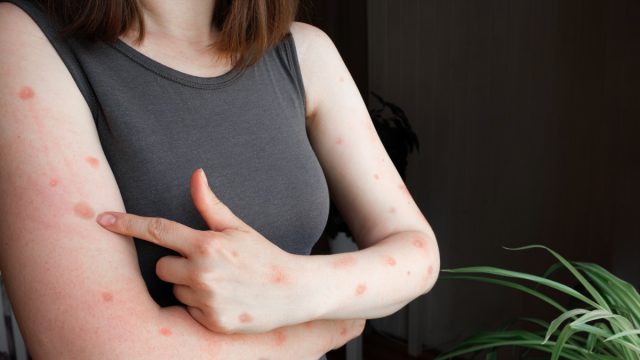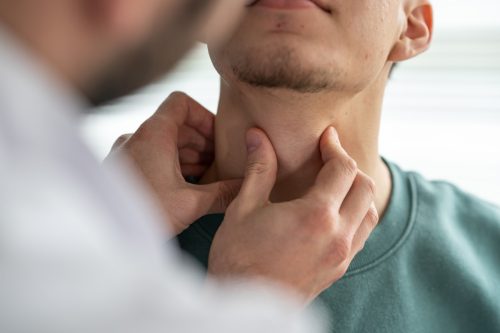Mpox Cases Have Been Surging Again, CDC Says—These Are the Symptoms
This disease is causing new concern in the U.S. following the 2022 outbreak.

Right on the heels of COVID, another virus had alarm bells ringing in 2022. In August of that year, the federal government declared a national public health emergency over the outbreak of mpox (formerly known as monkeypox) after more than 7,100 people in the country had been infected.
But while panic over this virus died down fairly quickly following that summer surge and a subsequent push for vaccination, new data from the Centers for Disease Control and Prevention (CDC) shows that mpox cases have been on the rise again.
The CDC's data shows that, as of March 16, there have been 511 mpox cases reported in the U.S. so far this year, CNN reported. That's nearly twice as high as the same time last year, when fewer than 300 cases had been reported by late March 2023.
"The increase in cases is a stark reminder of the virus's presence and the ongoing need for vigilance and preventive measures," John Brownstein, PhD, infectious disease epidemiologist and chief innovation officer at Boston Children's Hospital, told ABC News.
A spokesperson also recently confirmed to The Hill that the U.S. is seeing more mpox cases than the country was a year ago, but added that there is still a "low level of risk for most people."
Mpox can "spread through direct contact with infected animals, through close contact (including intimate contact) with a person with mpox, and through direct contact with contaminated materials," according to the CDC. The agency explains that this viral disease is caused by the monkeypox virus, which is part of the same family of viruses as the virus that causes smallpox.
"Mpox is rarely fatal and its symptoms are similar to smallpox, but milder," the CDC states.
Still, some people may face a higher risk of severe illness with mpox—especially if they're an infant, immunocompromised, pregnant, or have a history of eczema. Concerns over the risk of another surge are also heightened now, as vaccination rates have started lagging, with most states having less than a quarter of the at-risk population fully vaccinated with the recommended two-dose Jynneos regimen, CNN reported.
"This has the potential to become a fairly prevalent infectious disease, but the advantage with mpox is, we have a vaccine that's effective," Marcus Plescia, MD, chief medical officer for the Association of State and Territorial Health Officials, told the news outlet. "We've had fairly good participation in the vaccination push, but we're not anywhere close to getting most of the at-risk population vaccinated. Until that happens, we're going to see outbreaks and upticks in cases in various places."
To help keep yourself safe as cases rise again, read on to learn more about the most common mpox symptoms you should know.
RELATED: 4 New Vaccines You Need This Year, CDC Says in New Warning.
1
Rash

The most recognizable sign of mpox is a rash that could form on your hands, feet, chest, face, mouth, or near your genitals, according to the CDC.
"The rash will go through several stages, including scabs, before healing," the agency states, noting that it may initially look like pimples or blisters and can be painful or itchy.
RELATED: Ulcer-Causing Skin Infection From Tropical Parasite Now Spreading in U.S., CDC Warns.
2
Fever

But you might not only have a rash if you're infected. Another common symptom of mpox is a fever—and during past outbreaks of the virus, this was often people's first sign of infection, according to the American Academy of Dermatology Association (AAD).
RELATED: Officials Issue Alert Amid "Incredibly Contagious" Mumps Outbreak—These Are the Symptoms.
3
Flu-like symptoms

Alongside a fever, people may also experience other flu-like symptoms early in their infection, including fatigue, headache, muscle aches, and chills.
According to the CDC, mpox symptoms usually start within 21 days of exposure to the virus.
"If you have flu-like symptoms, you will likely develop a rash one to four days later," the agency explains.
4
Respiratory issues

You may also confuse mpox for the flu or a cold, because the CDC says that some people experience more respiratory symptoms with their infection as well. This can include a sore throat, nasal congestion, or cough.
5
Swollen lymph nodes

In many mpox cases, people will also develop swollen lymph nodes—which the CDC calls a "characteristic feature" of the disease. Lymph nodes may swell in your neck, armpits, or groin, and swelling can occur on both sides of the body or just one.
Best Life offers the most up-to-date information from top experts, new research, and health agencies, but our content is not meant to be a substitute for professional guidance. When it comes to the medication you're taking or any other health questions you have, always consult your healthcare provider directly.
- Source: CDC: About Mpox
- Source: CDC: Mpox Symptoms
- Source: CDC: Key Characteristics for Identifying Mpox





















